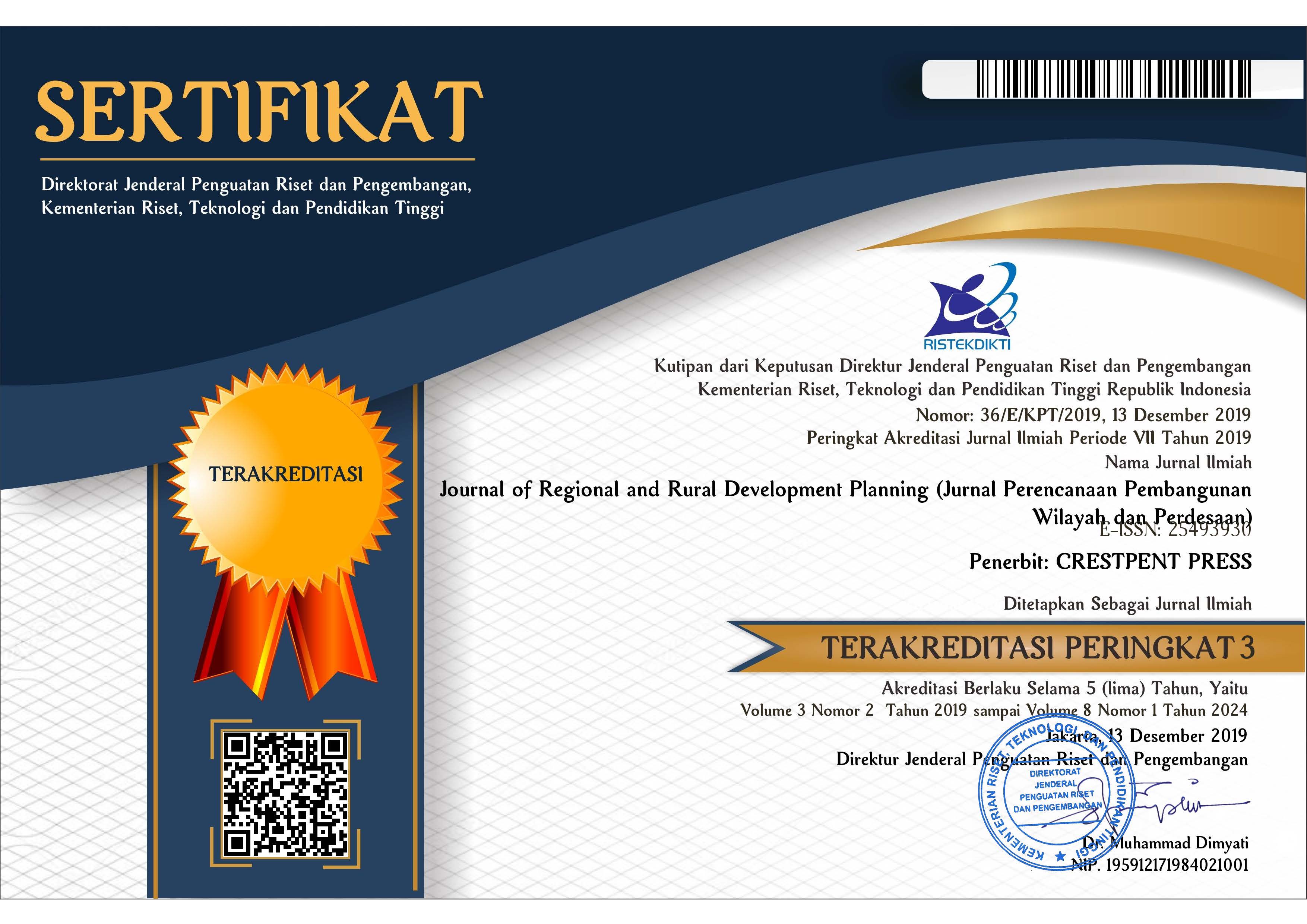Integrasi Ekonometri dalam Efektivitas Perencanaan menuju Penyediaan Perumahan yang Berkelanjutan
Econometric Integration in Planning Effectiveness toward Sustainable Housing Provision
Abstract
In accelerating spatial planning, an effective instrument is needed in planning so that the implementation of space utilization is in accordance with the expected goals, so that resources remain efficient, investment calculations become more real, and environmental balance in sustainable urban development is maintained. Housing development is often delayed (planning delay) due to the inefficient land provision process. On the other hand, the housing backlog is increasing to 800,000 units per year, thus it is necessary to investigate the effectiveness of planning, especially in the housing sector that has been running in Indonesia. Econometry as a quantitative approach with various variances of analysis techniques has many benefits but has not been widely integrated in planning, especially in calculating the effectiveness of instruments in achieving spatial planning goals. This article aims to examine the effectiveness of planning, especially related to land value and housing development through an econometric model approach by taking samples in Surabaya. The technique used is multiple regression analysis which shows the level of influence between six independent variables, namely land area, building area, land value, land price increases, property prices, and property taxes on the dependent variable, namely the effectiveness of planning indicated in the form of time required to implement the plan. The results show that there are 3 variables of the 6 independent variables that are proven to have an influence based on their significance value, namely land area, land value, and the percentage of increase in land value. Based on the regression results, it takes an average of -0.274 years to be constant, if other variables are considered absent, or it is interpreted that the phenomenon of housing development tends to precede or independent of housing planning in the sectoral plans and spatial plans.
References
Ball, M. (2011). Planning Delay and the Responsiveness of English Housing Supply. Journal of Urban Studies, 48 (2), 349-362.
Beckers, P. (2021). Time to Develop: A quantitative analysis on the effect of price uncertainty on development timing in the Netherlands. Master Thesis. Radboud University.
Bramley, G. (1998). Measuring planning: indicators of planning restraint and its impact on housing land supply. Environment and Planning B: Planning and Design, 25(1), 31-57.
Bramley, G. (2013). Housing market models and planning. The Town Planning Review, 84 (1), 9-35.
Caesar, C. (2016). Municipal land allocations: integrating planning and selection of developers while transferring public land for housing in Sweden. Journal of Housing and the Built Environment, 31, 257-275.
Cobban, J.L. (1993). Government Housing Policy in Indonesia 1900-1940. GeoJurnal: Kluwer Pub.
Colombijn, F. (2011). Public Housing in Post-Colonial Indonesia: The Revolution of Rising Expectation. Bijdragen tot de Taal, Land, en Volkenkunde, 167 (4), 437-458.
Damayanti, A.P., Hardiana, A., Rahayu, P. (2019). Faktor-Faktor yang Mempengaruhi Perkembangan Permukiman di Wilayah Pesisir Kabupaten Purworejo. Jurnal Pembangunan Wilayah dan Perencanaan Partisipatif, 14 (2), 154-172.
Gujarati, D.N., Porter, D.C. (2009). Basic Econometrics. McGraw-Hill, New York.
Lollyanti, V., Normelani, E., Adyatma, S. (2017). Faktor Penyebab Pengembang Memilih Lokasi Perumahan di Kecamatan Sungai Tabuk Kabupaten Banjar. Jurnal Pendidikan Geografi, 4 (1), 19-26.
Lucassen, T. (2020). The Dutch challenges: spare capacity, shortage of housing and soaring rental prices; A quantitative analysis about the relationship between plan capacity, housing production and rental prices in the private rented sector in the Netherlands. Master Thesis. Radboud University.
Mendrofa, A., Wibowo, H., Sofyan, I., Hendrawan, T., Witria, W. (2018). Faktor-Faktor yang Berpengaruh dalam Keputusan Pembelian Rumah untuk Masyarakat Berpenghasilan Rendah. Indonesian Business Review, 1 (1), 35-50.
Moochtar, R. (1980). Urban Housing in Indonesia. Habitat International, 4 (3), 325-338. Pergamon Press, Great Britain.
Nurdiani, N. (2010). Pola Pengembangan Rumah di Kampung Kota dan Faktor-Faktor yang Mempengaruhinya. ComTech, 1 (2), 1041-1052.
Nuzullia, L., Pradoto, W. (2015). Faktor-Faktor yang Mempengaruhi Perkembangan Kawasan Permukiman Terencana Kota Depok. Jurnal Teknik PWK, 4 (1), 145-159.
Peraturan Daerah Kota Surabaya Nomor 8 Tahun 2018 tentang Rencana Detail Tata Ruang dan Peraturan Zonasi Kota Surabaya Tahun 2018 – 2038
Rukmana, D. (2018). Upgrading Housing Settlement for The Urban Poor In Indonesia: An Analysis Of The Kampung Deret Program. Metropolitan Governance in Asia and the Pacific Rim: Borders, Challenges, Futures. Springer. B Grants et al (eds.)
Sadyohutomo, M. (2016). Tata Guna Tanah dan Penyerasian Tata Ruang. Pustaka Pelajar, 61-73.
Setiawan, B. (2020). Transformasi Perkotaan di Indonesia. Deepublish, Yogyakarta.
Silas, J. (2016). Perumahan dalam Jejak Paradoks. Laboratorium Perumahan dan Permukiman. Jurusan Arsitektur, FTSP ITS.
Supriyanto, B. (1999). Rekayasa Penilaian: Makalah Penilaian Tanah. Diktat Kuliah Universitas Tarumanegara, 11-23.
Trikorawati, I. (2002). Faktor-Faktor yang Menentukan Pilihan Bertempat Tinggal di Tepi Sungai Mahakam Tenggarong. Thesis. Universitas Gadjah Mada.
Van der Krabben, E., & Needham, B. (2008). Land readjustment for value capturing: A new planning tool for urban redevelopment. The Town Planning Review, 79 (6), 651-672.
Wantri, U., Alviawati, E., Arisanty, D. (2016). Faktor Penyebab Pengembang Memilih Lokasi Perumahan di Kecamatan Martapura Kota Kabupaten Banjar. Jurnal Pendidikan Geografi, 3 (3), 36-45.
Copyright (c) 2022 Journal of Regional and Rural Development Planning (Jurnal Perencanaan Pembangunan Wilayah dan Perdesaan)

This work is licensed under a Creative Commons Attribution-ShareAlike 4.0 International License.




.png)














